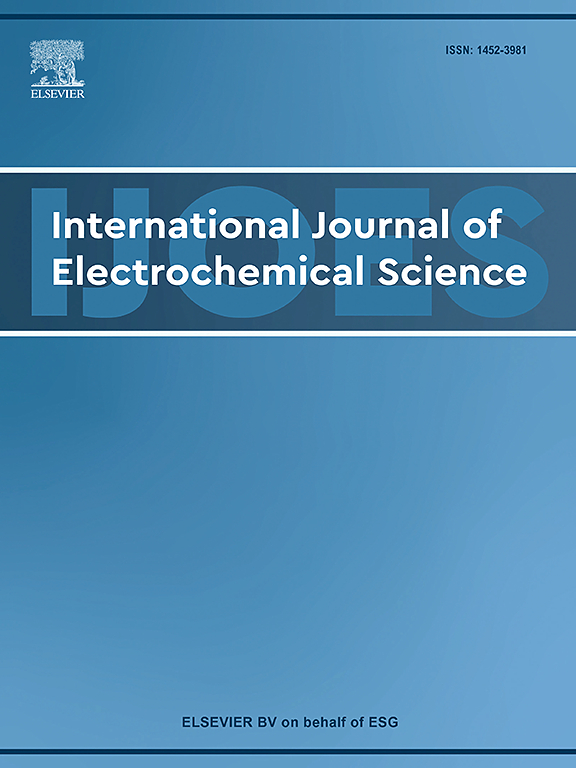Investigation of the corrosion inhibition of X42 carbon steel in CO₂-saturated brine using phaseolus vulgaris L. Bean extract
IF 2.4
4区 化学
Q4 ELECTROCHEMISTRY
International Journal of Electrochemical Science
Pub Date : 2025-10-14
DOI:10.1016/j.ijoes.2025.101210
引用次数: 0
Abstract
This study introduces a green corrosion inhibitor derived from white bean (Phaseolus vulgaris L.) extract (PVL), an abundant agricultural source, for X42 carbon steel in a CO₂-saturated 3.5 wt% NaCl solution. The anticorrosion performance of the synthesized PVL-extract was evaluated over a concentration range of 50–1000 ppm using weight loss, electrochemical polarization, and impedance spectroscopy (EIS). According to the results, the optimal concentration was 500 ppm, which reduced the corrosion rate by 95.9 ± 8.8 % (from 34.0 ± 2.0 mpy to 1.4 ± 0.3 mpy) and the corrosion current density by 94 ± 1 % (from 12.1 ± 0.2 µA/cm² to 0.7 ± 0.09 µA/cm²), while increasing charge transfer resistance by 88.8 ± 3.6 % (from 330 ± 5 Ω·cm² to 623 ± 7 Ω·cm²). Considering various adsorption isotherms, it was determined that the adsorption of PVL-extract on the carbon steel substrate obeyed the Langmuir adsorption isotherm. AFM provided quantitative surface analysis, revealing a dramatic reduction in average roughness (Sa) from 78 nm (Ra = 285 nm) on the blank coupon to just 0.86 nm (Ra = 5.6 nm) on the sample protected by 500 ppm PVL-extract. This profound smoothing effect was also visually confirmed by SEM. FTIR spectroscopy confirmed the adsorption of the tested inhibitor on the surface of the tested coupons, and UV-Vis spectroscopy verified the formation of inhibitor-iron complexes.
菜豆提取物对X42碳钢在CO 2饱和盐水中的缓蚀作用研究
本研究介绍了一种从丰富的农业资源白豆(Phaseolus vulgaris L.)提取物(PVL)中提取的绿色缓蚀剂,用于X42碳钢在co2饱和3.5 wt% NaCl溶液中的缓蚀剂。在50-1000 ppm的浓度范围内,通过失重、电化学极化和阻抗谱(EIS)来评估合成的pvl提取物的防腐性能。结果表明,最优浓度是500 ppm,这降低了腐蚀速率95.9 ±8.8 %(从34.0 ±2.0 mpy 1.4 ±0.3 mpy)和腐蚀电流密度在94年 ± 1 %(从12.1 ±0.2 µ²/厘米至0.7 ±0.09 µ²/厘米),而电荷转移电阻增加88.8 ±3.6 %(从330年 ± 5Ω·厘米²623 ± 7 cm²Ω·)。综合考虑各种吸附等温线,确定pvl萃取液在碳钢基体上的吸附服从Langmuir吸附等温线。AFM提供了定量表面分析,显示平均粗糙度(Sa)从空白券上的78 nm (Ra = 285 nm)急剧降低到500 ppm pvl提取物保护的样品上的0.86 nm (Ra = 5.6 nm)。这种深刻的平滑效果也被SEM直观地证实。FTIR光谱证实了被测抑制剂在被测券表面的吸附,UV-Vis光谱证实了抑制剂-铁配合物的形成。
本文章由计算机程序翻译,如有差异,请以英文原文为准。
求助全文
约1分钟内获得全文
求助全文
来源期刊
CiteScore
3.00
自引率
20.00%
发文量
714
审稿时长
2.6 months
期刊介绍:
International Journal of Electrochemical Science is a peer-reviewed, open access journal that publishes original research articles, short communications as well as review articles in all areas of electrochemistry: Scope - Theoretical and Computational Electrochemistry - Processes on Electrodes - Electroanalytical Chemistry and Sensor Science - Corrosion - Electrochemical Energy Conversion and Storage - Electrochemical Engineering - Coatings - Electrochemical Synthesis - Bioelectrochemistry - Molecular Electrochemistry

 求助内容:
求助内容: 应助结果提醒方式:
应助结果提醒方式:


